Plant stem cell signaling involves ligand-dependent trafficking of the CLAVATA1 receptor kinase
- PMID: 21333538
- PMCID: PMC3072602
- DOI: 10.1016/j.cub.2011.01.039
Plant stem cell signaling involves ligand-dependent trafficking of the CLAVATA1 receptor kinase
Abstract
Background: Cell numbers in above-ground meristems of plants are thought to be maintained by a feedback loop driven by perception of the glycopeptide ligand CLAVATA3 (CLV3) by the CLAVATA1 (CLV1) receptor kinase and the CLV2/CORYNE (CRN) receptor-like complex. CLV3 produced in the stem cells at the meristem apex limits the expression level of the stem cell-promoting homeodomain protein WUSCHEL (WUS) in the cells beneath, where CLV1 and WUS RNA are localized. WUS downregulation nonautonomously reduces stem cell proliferation. Overexpression of CLV3 eliminates the stem cells, causing meristem termination, and loss of CLV3 function allows meristem overproliferation. There are many questions regarding the CLV3/CLV1 interaction, including where in the meristem it occurs, how it is regulated, and how it is that a large range of CLV3 concentrations gives no meristem size phenotype.
Results: Here we use genetics and live imaging to examine the cell biology of CLV1 in Arabidopsis meristematic tissue. We demonstrate that plasma membrane-localized CLV1 is reduced in concentration by CLV3, which causes trafficking of CLV1 to lytic vacuoles. We find that changes in CLV2 activity have no detectable effects on CLV1 levels. We also find that CLV3 appears to diffuse broadly in meristems, contrary to a recent sequestration model.
Conclusions: This study provides a new model for CLV1 function in plant stem cell maintenance and suggests that downregulation of plasma membrane-localized CLV1 by its CLV3 ligand can account for the buffering of CLV3 signaling in the maintenance of stem cell pools in plants.
Copyright © 2011 Elsevier Ltd. All rights reserved.
Figures
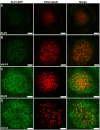
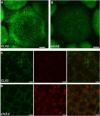
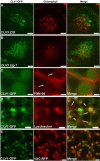
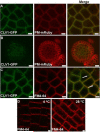
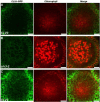

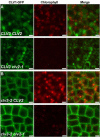
References
-
- Brand U, Fletcher JC, Hobe M, Meyerowitz EM, Simon R. Dependence of stem cell fate in Arabidopsis on a feedback loop regulated by CLV3 activity. Science. 2000;289:617–619. - PubMed
-
- Clark SE, Running MP, Meyerowitz EM. CLAVATA3 is a specific regulator of shoot and floral meristem development affecting the same processes as CLAVATA1. Development. 1995;121:2057–2067.
-
- Lenhard M, Laux T. Stem cell homeostasis in the Arabidopsis shoot meristem is regulated by intercellular movement of CLAVATA3 and its sequestration by CLAVATA1. Development. 2003;130:3163–3173. - PubMed
Publication types
MeSH terms
Substances
Grants and funding
LinkOut - more resources
Full Text Sources
Other Literature Sources
Molecular Biology Databases
Miscellaneous

